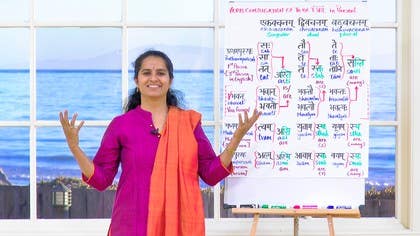Description
About This Video
Transcript
Read Full Transcript
Namo namaha. Welcome back again. We've explored the verb to be and seen its conjugation in the different forms in the present tense. This verb to be is really about the secret of existence itself. If we get a hang of it and if we know how it represents itself in all the different persons, first person, second person, third person, singular, dual, plural, we start getting quite a deep insight into what the universe is and it's all about to be or not to be, you know, finally. So let's have a look at all the forms of the verb to be in the present tense. It's quite an elaborate chart here but don't let this scare you. I've just put all the possible combinations in a simple form still here. So when we talk of the person, which person is, we then talk of the third person. Now in Sanskrit like I would like to mention, we have the word pratthama purushah which is actually the first person in Sanskrit but it corresponds to the English third person. So I've just mentioned it so that there's no confusion in your head. You have to just know which system you're functioning in. If you're talking of the Sanskrit system of the persons performing the action, then we would talk of pratthama purushah, the first person who represents the he, she, it. Then we have the madhyama purushah or the middle person that's you which corresponds to the English second person and then we have the uttama purushah or the best person and that corresponds to the first person in English. Alright, so we also have it in the singular, the dual and the plural. Masculine, feminine, neuter pronouns. You respect and you respect masculine, you respect feminine. The good news is that all these together will give us the same form of the verb. So we had a look at asti and nasti. So asti was for the third person singular in the present tense and that is asti. So saha asti sa asti tat asti. He is, she is, that is. You formal man is, you formal female is but it's R in English but to know that the same verb form is used. Alright, so asti. Moving on to the dual, we have he too, she too, they too. Taha, taha. You too formal. Men and women, taha. Got that? So asti, taha and then we move on to the plural and the same case. They men are, they women are, those things are. So te santi, taha santi, tani santi and those men, you men with respect, bhavantaha santi and you ladies with respect, bhavatya ha santi. Got that? So what you need to remember here because what we are trying to do at this stage is really to understand how the verb to be is conjugated. So I won't really walk my head around the trying to get the pronouns at this stage because we've already worked with the pronouns a little bit and by now you should be familiar with it. Gradually with some practice more you see it the easier it gets. So in your head the matrix that's important is third person singular dual plural, second person singular dual plural, first person singular dual plural. That's the matrix. And the verb conjugation is asti, staha, santi. Got that? Asti, staha, santi. Your head has to fill in all the other information as you're saying it. Now thinking of the middle person or rather the second person informal, we have thwam you, asi. Thwam, asi. You too, you vam, staha. You vam, staha. Now you plural, you yam, stha. You yam, stha. So there we go. Again you need not say these because they are understood. If you just said asi we would know it's you are. Staha, you too are. Stha, you many are. So asi, staha, stha. We next move on to the I, the first person. So I is aham and with aham it's easy to remember because you put the English me at the end of the verb. So you get aham asmi, I am. One of the most important statements of the Upanishads, the declarations of the Sanatana dharma is I am that, aham brahma asmi. You put it together with the sounds aham brahma asmi. Again aham brahma asmi, uttamam. The second declaration actually is when I know that I am that, the second declaration is that thwam asi, that you are. In fact if I just told it to you by now you can recreate it in terms of the meaning because that thwam asi, that you are. So not just I am that, but you are also that. Moving on to the verb itself, we have aham asmi, I am. The two of us, avam, swaha, avam, swaha, vayam, many of us, smaha, vayam, smaha.
So now just watch these verb formations with me and say it asmi, swaha, smaha, great. So now drop all the pronouns out of the way. Just drop this whole thing out of the way and we will just say the verb to be conjugated with the different people and the different numbers. Ready? So asti, staha, sandhi, asi, staha, stha, asmi, swaha, smaha. Got that? I suggest you close your eyes, I will say it out to you and just let the sound fall in your system. Asti, staha, sandhi, asi, staha, stha, asmi, swaha, smaha. That's all of the verb to be in the present tense. Try and say it now once together with me. Asti, staha, sandhi, asi, staha, stha, asmi, swaha, smaha. I will do it with you once more but this time I will say them faster and I will say just each line and repeat after me. Alright? We will say it first. Asti, staha, sandhi, asi, staha, stha, asmi, swaha, smaha. Great. So let's practice that together on your own. Say it as often as you can and discover the essence of being in the present. Namaste.
Mother Tongue: Verbs
Comments
You need to be a subscriber to post a comment.
Please Log In or Create an Account to start your free trial.










